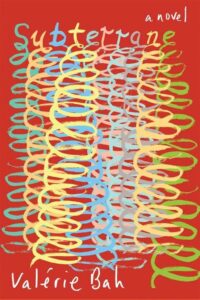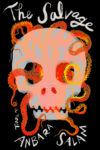
[Véhicule Press; 2024]
Valérie Bah’s new novel, Subterrane, is kaleidoscopic. It’s set in New Stockholm—a speculative metropolis of affluent professionals. More specifically, its narrow art scene, shaped by scarcity and the whims of the elite. Meanwhile, the city’s “urban renewal project” looms, threatens, and gradually presses its more precarious residents into the polluted fringes. Then, there’s Zeynab—the newly anointed artist—with a pitch. She wants to chronicle the resistance, and she does, to some extent.
The novel’s scope is broader than Zeynab, alone. It includes a carousel of perspectives: activists, artisans, rootworkers, performers, many of whom are struggling with dead-end jobs and the threat of yet another displacement. The settings are rife with the impact of corporate urban policy, but the novel is also attentive to its spiritual, artistic, and communal consequences. I think that’s why, in reading it, I kept thinking about Sarah Schulman’s 2012 book, The Gentrification of the Mind: Witness to a Lost Imagination. Schulman chronicles the coincidence of the AIDS epidemic and policies aimed at attracting wealthy people to New York City. Schulman notes that the transformation of neighborhoods was already dramatically underway, when the epidemic peaked. When large numbers of gay men started dying, their apartments were turned to market rate. Developers swooped in and the pace at which dynamic communities were converted into homogenized strips of fusion restaurants, boutiques, and luxury apartments accelerated. A new professionalized class of people, Schulman explains, supplanted the multiple perspectives characteristic of mixed neighborhoods, replacing it with their suburban sensibilities. Gentrification, as Schulman describes it, isn’t just the displacement of communities and their replacement. It’s also the spiritual consequence of that erasure.
Subterrane doesn’t use the term “gentrification.” It refers to the land and its people as “the colony,” a gesture that locates the phenomenon in a broader continuum. New Stockholm is the product of a colonialist legacy. The novel attends to the ways such a legacy has shaped understandings of class, culture, gender, and sexuality. The corporation that plans to pave over the community is also a military contractor, which—I think—further characterizes expropriative urban policy as an extension of military occupations and the more entrenched and institutionalized violence of settler-colonial countries.
Subterrane cycles through so many characters and perspectives, including that of Dom, a stowaway world builder; Phyllida, a maker and a Maroon; Mattie, a doyenne; and Tamika, a rootworker, among others. But Zeynab’s point of view frames the narrative. It opens in the lobby of the Film Commission, while Zeynab mentally prepares her pitch. She wants to document the urban renewal project. She plans to center a handful of activists who’ve destroyed equipment complicit in the dismantling of their neighborhoods. The novel opens with a slow, sweeping pan of the Film Commission, yet it has the focus of a static shot. It begins with a single and sustained scene that moves from the “blunt authority” of the brutalist architecture to the lobby’s “soothing blandness.” The chapter is remarkably bereft of direct dialogue, though nearly every sentence captures relationality through power differentials. Framed posters of past projects, displayed in chronological order, animate the otherwise dull interior and showcase the institution’s evolution. The “self-satisfied” hum of the building’s central heating is the only sound inside, which is set at a sonic and psychological distance from the street. Zeynab waits. She observes the space. The sedate formalities of those who belong to it and the latent desperation of those who don’t. Eventually, Zeynab is ushered into an austere meeting room. The lead producer is a white man who “makes insufficient eye contact.” He’s described as “the passive recipient of structural advantages.” The associate producer, in contrast, is “hungry. Razor sharp. Speaks in clipped sentences.” Zeynab gathers immediately that she’s the one in charge, the one to win over. The scene, remarkably, captures—beat by beat—the nuance of the exchange while conveying everything save what’s spoken. There is no direct dialogue. Yet, the dynamic is crystal clear. The buzzwords and airy disavowals are of little import. Power is the institutional message and every element of the scene—save what’s spoken—conveys this:
To an institution like this, what is a story but a commodity? By its logic, people, pain, and places are inputs to games of shadow and light that generate cultural capital meant to reify the state’s legitimacy. Somewhere, a few floors down, digital and material archives swell the coffers and influence the colony’s imagination of itself.
Zeynab knows the purpose of such institutions and she knows her role. She’s hungry, desperate. She needs the grant to finish her project, but she resents the institutionalized art world, even as she draws parallels between the film commission’s stranglehold on reality and her own artistic practice:
She resents approaching these illegitimate gatekeepers, positioning herself as a native informant to be vetted by a set of government officials who will have the final say in constructing her or other people’s story. And yet, she sits there, rehearsing points, tying together her narrative arc, sanding down the edges of nuance, whittling down flesh and blood people into protagonists, into a three-act structure.
The Film Commission is a self-satisfied machine. It replaces reality with the fantasy of its own benevolence. Zeynab’s position is fraught, and she knows it. She’s the child of political asylum seekers, raised in a dismantled social housing project. She’s also been impacted by corporate urban policy. She packages the past as her in or her angle—the common ground she shares with those who will be displaced. Yet, her inner monologue is peppered with self-condemnation. She labels herself, “a native informant.” The narrator describes her as an artist, who “will do anything for her art.” She’s mercurial. What she’s willing to do is contextual. In this passage, she’s willing to whittle reality into a palatable formula. It pays. Her pitch is a success. She identifies with the experience of the activists she interviews. She isn’t New Stockholm or its Film Commission. And yet she knows she’s eulogizing her subjects in real time, “tightening her hold” in an “exquisite corpse portraiture session over which they [have] no control.” It is, perhaps, Zeynab’s relationship to the content that leads Maya, the “camera operator,” to characterize the project as Zeynab’s “personal healing quest” and a circumvention of her accountability to the public—as if her subjects have become the inert materials of her self-expression.
In The Gentrification of the Mind, Sarah Schulman offers a cogent gloss of the social theorist Herbert Marcuse’s term “repressive tolerance.” Schulman describes it as a process by which “communities become distorted and neutered [through] the dominant culture’s containment of their realities.” She goes on to say that the “dominant culture doesn’t change how it views itself or how it operates, and power imbalances are not transformed. What happens instead is that the oppressed person’s expression is overwhelmed by the dominant person’s inflationary self-congratulation about how generous they are.” Zeynab doesn’t represent the dominant culture, nor is she—entirely—a part of the community her film represents. While the Film Commission certainly partakes in that inflationary self-congratulation, I don’t think that wording characterizes Zeynab’s attitude, nor does the word “self-congratulatory” capture the audience’s reaction. Far from it. The audience–students, practitioners, academic stars, tastemakers, and intellectual drifters—see the film as a provocation or accusation. It inspires dread:
Dread that usually comes to them when they are asked something about themselves, which is how they interpret this work. It’s about them. A 90-minute interrogation that will ask them to shift their understanding of the residents of Cipher Falls.
The term “repressive tolerance” and the gloss Schulman provides isn’t a neat fit. Zeynab’s critique isn’t neutered, exactly. And yet, I find the term useful. It helps describe the impact of Zeynab’s film. Her film asks audience members to change how they view the displaced. But to do this they must change how they view themselves, and they don’t want to. So, they twist in their seats, feeling scrutinized and provoked. They balk at the insult. By the time the Q&A rolls around, their discomfort has turned to ire and their ire has found its target: the artist, Zeynab, the cause of their discomfort. She’s imperfect. A hypocrite. Her transgressions delegitimize her insights, right?
One, among many, brilliant strokes of Bah’s novel is the structure. It’s a network narrative. So, there are so many perspectives from characters whose life circumstances, positions, and beliefs vary. Several of these personalities engage–in some manner or another–with Zeynab and her art. Their criticism and praise are kaleidoscopic. To Doudou Laguerre—the rabble rouser, muse, and activist—Zeynab’s will to understand is an attempt to incorporate and control his manifestly different value system. Maya, the project’s camera operator, vacillates between befuddled reverence and moral indignation, at times deeming Zeynab yet another esoteric artist, who makes “mausoleums out of her trauma.” Then, there’s the staff of the Film Commission, who fawn over Zeynab as well as the producers who look at her “like she’s the second coming of the Black Madonna.” In sharp contrast, Zeynab sees herself as a conduit or does not see herself at all or—as Maya, her soon-to-be discarded lover (and, yes, camera-operator), suggests—Zeynab refuses to look at herself or the troubled past that haunts her artistic and interpersonal life.
While Bah’s novel chronicles the making of Zeynab’s documentary, from pitch to reception, and, in some respects, Zeynab’s process takes center stage, Bah also weaves a rich tapestry of characters, whose art lacks institutional funding and whose lives and labor buttress and incite—if unwittingly or unwillingly—Zeynab’s project. These characters’ lives and art resist, in many ways, colonial and artistic capture.
There is Dom, who makes a new world while squatting in the attic of a convenience store. There’s Mattie, the artisan and doyenne, who reads Zeynab’s ailment in her scalp, seeing there “a crooked reflection of everything I don’t have. Ambition. A driving force and vicious streak. A pattern of late nights and bewilderment and a dangling carrot of validation. Eating at her edges.” She pours blessings into Zeynab’s scalp and heals her, to the extent that she can. There’s also Phyllida, the maker, and Tamika, the rootworker, whose artistic practices resist outcome, and categorization. They resist the notion that one’s value resides in their ability to work and commodify their output. Their practices are embodied, ephemeral.
Cipher Falls, New Stockholm’s last affordable neighborhood, gets paved over, while scholars debate the ethical and artistic merits of Zeynab’s documentary. Yet the trans and queer artistic renegades do not disappear. They struggle and continue making art together.
Jessica Alexander‘s novella, None of This Is an Invitation (co-written with Katie Jean Shinkle), was published by Astrophil Press in summer 2023. Her story collection, Dear Enemy, was the winning manuscript in the 2016 Subito Prose Contest, as judged by Selah Saterstrom. Her collaborative memoir (co-written with Vi Khi Nao), That Woman Could Be You, came out with BlazeVox in April 2022. Her novel, Agnes, We’re Not Murderers, is forthcoming from Clash Books.
This post may contain affiliate links.






